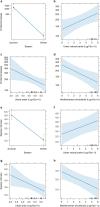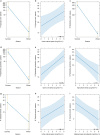Landscape and Season Influence Bat Activity and Richness in a Mediterranean Metropolitan Area
- PMID: 40809820
- PMCID: PMC12349923
- DOI: 10.1002/ece3.71978
Landscape and Season Influence Bat Activity and Richness in a Mediterranean Metropolitan Area
Abstract
Urbanisation alters landscapes and filters biodiversity, yet its effects in Mediterranean cities remain poorly understood despite their unique ecological and climatic context. As adaptable insectivores and key providers of ecosystem services, bats are an important component of urban biodiversity. We investigated how landscape composition, artificial illumination, and seasonality shape bat activity and species richness in Naples (Southern Italy), a densely inhabited Mediterranean metropolis. We hypothesized that: (1) artificial illumination would favor light-tolerant species; (2) urban areas would enhance bat activity through roosting and foraging opportunities; and (3) urban warming would reduce seasonal declines in activity. Passive ultrasonic recorders were deployed in summer and winter across 12 1 × 1 km cells spanning a gradient of green space size and fragmentation. We recorded seven species and one Myotis group, with communities dominated by synurbic taxa (Pipistrellus kuhlii, Hypsugo savii, Pipistrellus pipistrellus). Artificial illumination did not influence activity, and no species responded positively to light. Urban land cover and Mediterranean shrublands reduced both total activity and species richness, and the hypothesis that urbanization would enhance foraging opportunities for tolerant species was rejected. In contrast, urban natural parks increased bat activity and richness, favoring H. savii and Tadarida teniotis, while P. pipistrellus preferred open rural areas but avoided intensively managed agricultural land.Pipistrellus Seasonality emerged as the most consistent driver: bat activity and richness declined markedly in winter for all species, including presumed urban exploiters such as P. kuhlii and H. savii. Even the mild Mediterranean climate and urban heat island effects did not eliminate strong seasonal patterns. Mediterranean cities act as environmental filters, supporting only a few tolerant species. Urban natural parks provide critical refugia and should be prioritized alongside habitat heterogeneity, reduced pesticide use, and light pollution mitigation. Despite urban warming, pronounced winter declines persist, highlighting the need for continued monitoring to detect climate-driven phenological shifts.
Keywords: Naples; bat; city; green areas; park; seasonality; urbanization.
© 2025 The Author(s). Ecology and Evolution published by British Ecological Society and John Wiley & Sons Ltd.
Conflict of interest statement
The authors declare no conflicts of interest.
Figures



References
-
- Ancillotto, L. , Budinski I., Nardone V., et al. 2018. “What Is Driving Range Expansion in a Common Bat? Hints From Thermoregulation and Habitat Selection.” Behavioural Processes 157: 540–546. - PubMed
-
- Ancillotto, L. , Guerri G., Agnelli P., et al. 2025. “Past Present: Extinction Debt of Forest Mammals From Urban Areas.” Biological Conservation 306: 111143.
LinkOut - more resources
Full Text Sources
Research Materials

